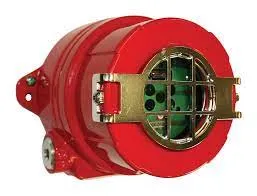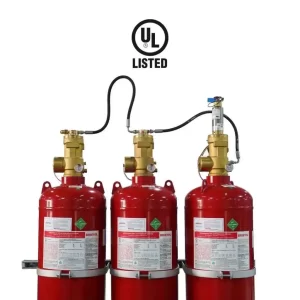FG system or fire and gas system (FG) is of obvious importance as a stable guard in environments that are exposed to fire and gas hazards. The system integrates advanced technologies to detect and manage fires and gas leaks, ensuring the safety of industries such as petrochemicals, refineries and manufacturing. Using a multifaceted network of sensors, alarms and automated responses, it proactively deals with various risks and ensures the uninterrupted operation of industrial facilities, while prioritizing personnel safety.
FG fire extinguishing system or flame and gas monitoring system is a safety system designed to detect and warn of fire or hazardous gases in industrial or commercial environments. This system has advanced and special capabilities, and due to its high cost, it is often used in high-risk areas such as petrochemical, refineries, power plants, and industrial factories, and it has anti-explosion equipment.
This system includes flame, gas, smoke, heat and smoke and heat combination detectors, which together with fire alarms and flashers, inform people about the occurrence of fire. This system is used in areas with explosive risk such as Zone and is classified as Z1, Z2 and Z3 based on the level of risk.
One of the big advantages of using the FG system is the faster and more reliable notification of a fire.
Factories and industrial environments, unlike warehouses, must be designed with respect to the volume of equipment and extensive manpower employed in them. Therefore, the appropriate fire extinguishing system for factories should be chosen in such a way that in times of danger, all people and equipment are protected and possible damages are minimized.

FG systems are designed to monitor fire and hazardous gases in industrial environments. This system consists of sensors and detectors that can detect fire, the presence of combustible gases and toxic gases. Strategic placement of these sensors is necessary in areas with high risk of fire or gas leakage. Instead, fire alarm systems, by detecting smoke, heat, or manual activation, activate warning alarms for people inside the building and often notify emergency services. The purpose of these systems is to ensure the safe evacuation of people and provide a quick response to fire.
– FG system: monitors fire and gas risks in industrial environments and responds to wider threats in these environments.
– Fire alarm system: the main focus of this system is on identifying and warning residents about the presence of fire inside the building.
– FG system: It is often installed in industrial environments such as petrochemical plants, refineries and production units where the risk of fire and gas leakage is higher.
– Fire alarm system: It is installed in commercial and residential buildings to ensure the safety of residents against fire.
By implementing an integrated gas and fire monitoring system, industries can meet their safety and protection requirements using the latest available technologies and fully insure their critical assets, including people and equipment.
The goals of the FG system include:
1. Reducing the risk and consequences of accidents.
2. Reducing the probability of dangerous events.
3. Ensuring a safe working environment for people.
4. Ensuring the existence of sufficient escape equipment.
5. Creating sufficient safety equipment to detect, isolate and minimize the leakage of toxic and flammable gases and liquids in the environment.
6. Setting up appropriate protection systems to control and quickly extinguish any foreseeable fire that is possible in everyday conditions and operations.
7. Minimizing the possibility of environmental pollution caused by leakage, discharge or accidental ignition of dangerous substances.
FG systems are of great importance due to the possibility of automating emergency actions to reduce the risks associated with the escalation of incidents. Also, the use of these systems is critical to quickly recover from abnormal conditions and resume full production. A typical FG safety system includes the functions of detection, control, warning and mitigation measures. The control panel plays a central role in the overall control and monitoring of the FG system. The controller receives alarm signals from field monitoring devices to detect fire and gas and then takes the necessary actions to activate the alarm and reduce the risk.
Fire and gas monitoring devices have made great progress in recent years. The use of new and smarter techniques of these tools has reduced the number of false alarms and improved the detection rate of the system. The correct connection of fire and gas detectors to the protection systems plays an important role in the reliable operation of the FG system and the establishment of the desired safety level (SIL). Currently, fire and gas monitoring systems are mostly programmable electronic systems (PES) that provide high security and effectively contribute to reducing risks. Also, modern FG systems are now fully integrated with the process safety strategy.
Although the FG system is used in various industries and fields, it is most commonly used in refineries and power plants. Additionally, other locations where FG systems are used include:
1. Oil platforms
2. Onshore oil and gas facilities
3. Petrochemicals
4. Chemical factories
5. Maritime operations
6. Tanks and terminals
7. Pipelines
8. Mines
9. Paper factories
In the past, FG systems equipment either operated independently or were connected to a control panel and controlled using relays. Control and risk reduction measures were also done manually. But these methods were not considered the best measures to reduce the risks by the gas and fire monitoring system. Today, these systems are generally programmable and are known as PES systems. Since these equipments work in an integrated manner with all environmental safety processes, hazard elimination measures are also performed through the emergency shutdown system or directly by the FG system.
An effective flame and gas monitoring system uses, in addition to flame and gas detectors, a standard and traceable fire alarm control panel, as well as clean fire extinguishing systems such as inert gases.
To design a proper FG system, risk analysis should be done. The report of this analysis will specify the system requirements, including the type of detectors used, the response speed of the detectors, the number of fire zoning, the performance of the alarm equipment and the information required.
However, flame and gas detectors are very important and we will examine their types below.

These detectors are divided into two main categories:
Gas detectors have different sensors based on their detection, which are catalytic (Catalytic / Pellistor), electrochemical (Electro Chemical), infrared (IR) and linear (Open Path).
These detectors include the following types based on the light spectrum they use to detect fire:
FG system is short for fire and gas monitoring system that continuously monitors for abnormal conditions such as fire or release of flammable and toxic gases.
FG system is most used in oil and gas industries, refineries and power plants.
Fire detectors and gas detectors are the two main types of detectors in FG fire extinguishing systems.

Imen Datis Asia Company is recognized as one of the top companies in the private sector in the field of safety and fire fighting, relying on modern knowledge, continuous activity and the cooperation of highly specialized forces. This group is always trying to continuously and dynamically expand the safety and firefighting infrastructure of our beloved country Iran and take great steps in order to achieve goals such as the development and industrialization of new technologies.
Imen Datis Asia company, with expertise in supplying and equipping fire alarm and extinguishing systems, is a leader in providing quality products and specialized consultations. With an experienced team, we are trying to provide the highest level of security and protection to our customers.
All material and intellectual rights of this site are reserved for Imen Datis Asia